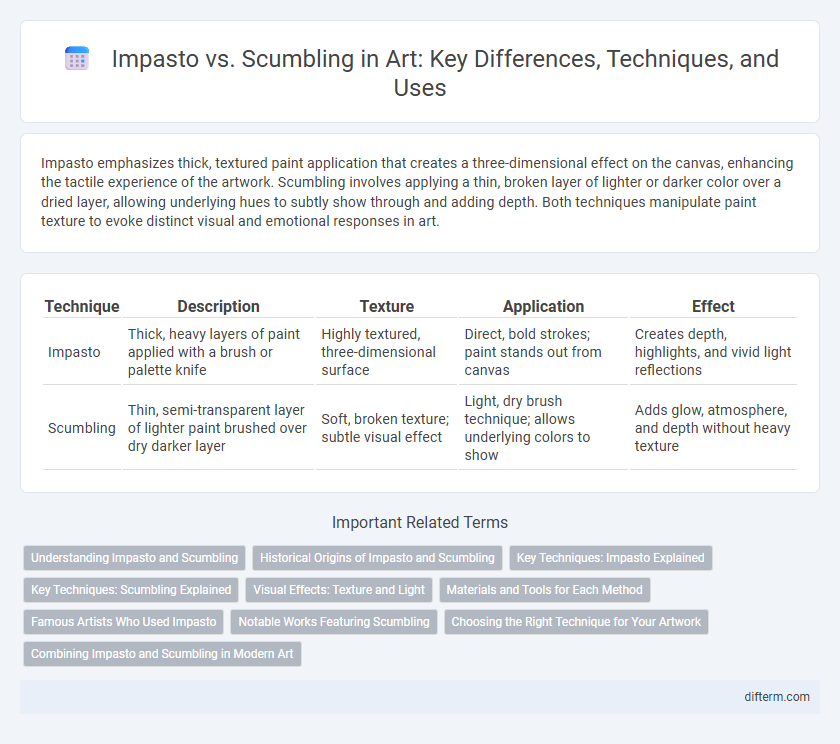Impasto emphasizes thick, textured paint application that creates a three-dimensional effect on the canvas, enhancing the tactile experience of the artwork. Scumbling involves applying a thin, broken layer of lighter or darker color over a dried layer, allowing underlying hues to subtly show through and adding depth. Both techniques manipulate paint texture to evoke distinct visual and emotional responses in art.
Table of Comparison
| Technique | Description | Texture | Application | Effect |
|---|---|---|---|---|
| Impasto | Thick, heavy layers of paint applied with a brush or palette knife | Highly textured, three-dimensional surface | Direct, bold strokes; paint stands out from canvas | Creates depth, highlights, and vivid light reflections |
| Scumbling | Thin, semi-transparent layer of lighter paint brushed over dry darker layer | Soft, broken texture; subtle visual effect | Light, dry brush technique; allows underlying colors to show | Adds glow, atmosphere, and depth without heavy texture |
Understanding Impasto and Scumbling
Impasto is a painting technique characterized by thick, textured layers of paint that create a three-dimensional surface, enhancing light reflection and adding dramatic depth. Scumbling involves applying a thin, semi-opaque layer of paint over a dry base layer, producing a soft, broken color effect that allows underlying tones to subtly show through. Mastery of impasto and scumbling techniques enables artists to manipulate texture and transparency, enriching visual interest and emotional expression in their artwork.
Historical Origins of Impasto and Scumbling
Impasto, tracing its origins to the Renaissance period, was first employed by artists such as Titian to create textured surfaces and enhance light effects in oil paintings. Scumbling, developed later during the Baroque era, refined surface texture by applying thin, opaque layers of pigment to achieve softer transitions and atmospheric depth. These techniques evolved as pivotal methods for manipulating light and texture, influencing notable art movements including Impressionism and Baroque.
Key Techniques: Impasto Explained
Impasto is a painting technique characterized by thick layers of paint applied to the canvas, creating a textured, three-dimensional surface that captures light and enhances the visual impact. This method, often used with oil or acrylic paints, emphasizes brushstrokes and palette knife marks, giving the artwork a dynamic and tactile quality. Unlike scumbling, which involves applying a thin, opaque layer to soften or modify underlying colors, impasto highlights texture and depth through its pronounced thickness.
Key Techniques: Scumbling Explained
Scumbling is a painting technique involving the application of a thin, broken layer of opaque or semi-opaque paint over a dry underlayer, creating a textured, soft-focus effect that allows lower colors to peek through. Unlike impasto, which emphasizes thick, three-dimensional paint buildup, scumbling relies on delicate, dry brushwork to generate subtle color modulation and atmospheric depth. This method is essential for achieving luminosity and tonal variation in landscapes and portraits by diffusing light and enhancing surface texture.
Visual Effects: Texture and Light
Impasto creates a thick, textured surface that enhances light reflection and adds dimensionality, making brushstrokes visibly prominent and dynamic. Scumbling applies a thin, broken layer of paint over a dry underlayer, allowing underlying colors to shimmer through and produce a soft, diffused light effect. These contrasting techniques manipulate texture and light to evoke distinct visual sensations and artistic depth.
Materials and Tools for Each Method
Impasto technique requires thick oil or acrylic paints applied with palette knives or stiff-bristled brushes to create textured, three-dimensional surfaces. Scumbling involves using dry, lightly loaded brushes and thin, semi-opaque layers of paint, often with softer bristle brushes or sponges, to achieve a subtle, broken color effect. Both methods demand specific materials for texture manipulation: impasto relies on heavy-bodied pigments, while scumbling exploits thin glazes and delicate application tools.
Famous Artists Who Used Impasto
Vincent van Gogh is renowned for his expressive use of impasto, applying thick layers of oil paint to create vivid textures and dynamic brushstrokes that enhance emotional intensity. Rembrandt van Rijn masterfully utilized impasto to achieve dramatic light effects and rich surface depth in his portraits and biblical scenes. Jackson Pollock also employed impasto techniques within his abstract expressionist works, building raised paint surfaces that contribute to the overall texture and movement.
Notable Works Featuring Scumbling
Notable works featuring scumbling include John Constable's "The Hay Wain," where delicate layers of paint create atmospheric depth and subtle texture. J.M.W. Turner's "Rain, Steam and Speed" showcases scumbling to evoke mist and movement with translucent, broken brushstrokes. These masterpieces demonstrate scumbling's ability to enhance light effects and visual complexity without the thick, raised texture characteristic of impasto.
Choosing the Right Technique for Your Artwork
Impasto technique creates texture through thick, layered paint that adds depth and tactile interest, ideal for emphasizing light and motion in expressive pieces. Scumbling applies a thin, broken layer of opaque or semi-opaque color over a dried base, enhancing subtle tonal variations and atmospheric effects. Selecting impasto or scumbling depends on desired texture intensity, visual impact, and the emotional tone of the artwork.
Combining Impasto and Scumbling in Modern Art
Combining impasto and scumbling techniques in modern art creates dynamic surface textures that enhance depth and visual interest. Impasto's thick, bold strokes contrast with scumbling's thin, broken layers, allowing artists to manipulate light and color interactions effectively. This fusion enriches contemporary artworks by blending tactile richness with subtle tonal variations.
impasto vs scumbling Infographic

 difterm.com
difterm.com